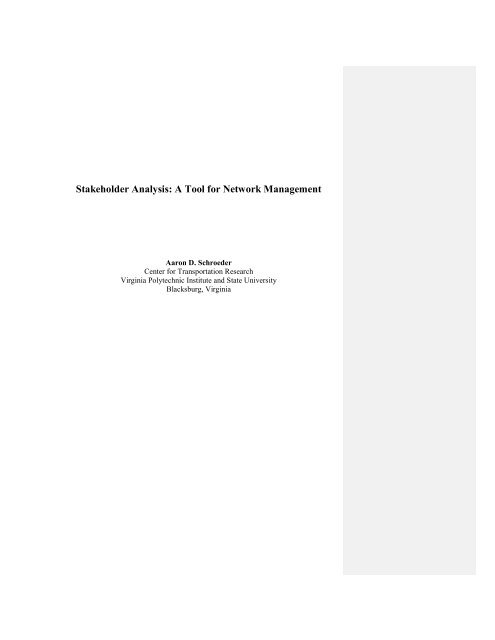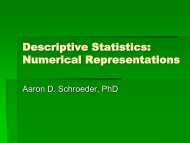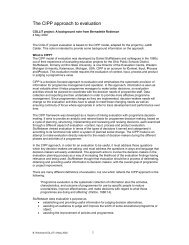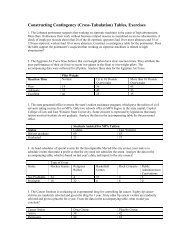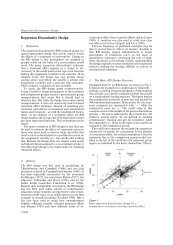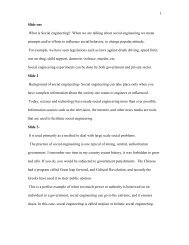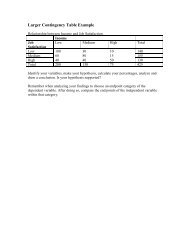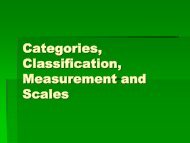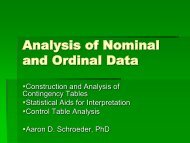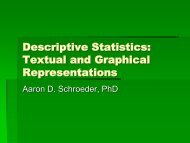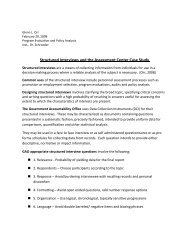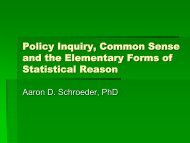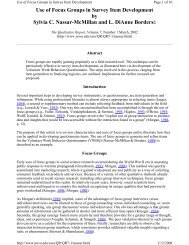The Problem
The Problem
The Problem
You also want an ePaper? Increase the reach of your titles
YUMPU automatically turns print PDFs into web optimized ePapers that Google loves.
Stakeholder Analysis: A Tool for Network Management<br />
Aaron D. Schroeder<br />
Center for Transportation Research<br />
Virginia Polytechnic Institute and State University<br />
Blacksburg, Virginia
Stakeholder Analysis: A Tool for Network Management<br />
2
Stakeholder Analysis – A Tool for Network Management<br />
I. Introduction – How do we know who should be at the table?<br />
As the theory and practice of public administration in this country has begun to move<br />
away from the concept of hierarchically-controlled, scientifically-based operations to<br />
more open, flatter, and citizen-inclusive “network” forms of management, the concept of<br />
“stakeholder inclusion” in the governance process has gained in prominence (deLeon,<br />
1992; Fischer, 1993). In fact, while it may be argued that the appropriate role of the<br />
“public” in public administration has been an active and ongoing area of inquiry and<br />
debate since the founding of this nation, a discernible contemporary movement to<br />
examine the role of the “public” in the process of administrative decision making has<br />
come about in the past three decades as a result of concern over citizen discouragement<br />
and apathy (Box, 1996; Putnam, 1995; Timney, 1996; Thomas, 1995, Schroeder and<br />
Wamsley, 1995). This trend is of profound importance to the field of public<br />
administration. Foremost is the effect that such an orientation has on the conceptual role<br />
of the administrator in the governance process.<br />
<strong>The</strong> concept of stakeholder analysis and management, and other theoretical approaches<br />
advocating increased public participation and deliberation, are scattered throughout the<br />
literature. Not only are agencies increasingly being mandated to incorporate some<br />
legitimate form of public/stakeholder participation process beyond the traditional notice<br />
and hearing standards (Rossi, 1997; Jones, 1997; Powell, 1997), but a valid and important<br />
normative/ethical component also exists (Donaldson and Preston, 1995; Clarkson, 1995;<br />
Tennert and Soden, forthcoming). As Donaldson and Preston put it, “<strong>The</strong> descriptive<br />
accuracy of the theory presumes the truth of the core normative conception, insofar as it<br />
presumes that managers and other agents act as if all stakeholders’ interests have intrinsic<br />
value. In turn, recognition of these ultimate moral values and obligations gives<br />
stakeholder management its fundamental normative base” (1995: 74). Moreover, these<br />
authors assert that “the ultimate managerial implication of the stakeholder theory is that<br />
managers should acknowledge the validity of diverse stakeholders interests and should<br />
3
attempt to respond to them within a mutually supportive framework, because that is a<br />
moral requirement for the legitimacy of the management function” (p. 87). In addition, it<br />
simply makes good “management” sense. That is, public administrators can no longer<br />
expect to be effective and seem equitable without incorporating multiple perspectives in<br />
the policy process (Tennert and Soden, 1998).<br />
However, little if anything has been done to help public sector managers devise tools to<br />
identify and manage relevant stakeholders, nor has the literature developed tools to deal<br />
with the various ways and situations different types of stakeholders can and should be<br />
included in a public-sector driven stakeholder process. That is, such tools are not well<br />
defined methodologically within the field of public administration. <strong>The</strong> problem is that<br />
most research in public administration takes stakeholders as a given. Many authors begin<br />
with the assumption that stakeholders are already known, or that stakeholders have<br />
already self-selected themselves to be involved in the process. <strong>The</strong> literature has done<br />
little, however, to contribute methods for identifying relevant stakeholders when they are<br />
not known, or identifying additional stakeholders when those that have self-selected do<br />
not adequately represent all interests at hand. While one may be tempted to conclude that<br />
those issues that generate little interest in potential stakeholder populations do not need<br />
stakeholder input, the experienced public administrator will most likely agree that the<br />
most difficult stakeholder situations arise after a decision has been made without a<br />
group’s consultation, regardless of the fact that they did not self-select into the process at<br />
the beginning.<br />
<strong>The</strong> reality of the public administrator’s daily life, in working to “get things done in the<br />
public interest,” is that most of the time, obvious, relevant stakeholders are not readily<br />
evident or self-selecting. Most of the literature which addresses stakeholder involvement<br />
addresses it within the context of highly visible, highly salient, and very often, highly<br />
controversial issues (e.g. environmental and land-use planning issues). In these incidents,<br />
many people, whether or not they were interested stakeholders initially, are familiar to<br />
some extent with the problem, and can accordingly self-select in or out of the process.<br />
<strong>The</strong> vast majority of issues to be addressed and/or programs to be implemented by the<br />
4
public administrator, however, are generally not “sexy” enough to generate the same kind<br />
of visibility or interest. That is, starting with an assumption that relevant stakeholders will<br />
magically self-select into the process results in the researcher focusing on areas of publiclife<br />
which represent the exception to the public manager’s daily life, not the rule.<br />
II. <strong>The</strong> <strong>Problem</strong><br />
If the public administrator is no longer “in charge” of a defined hierarchy of his/her<br />
employees, all administered through the concepts of a clear line-of-authority and span-ofcontrol,<br />
then what is the role of the public administrator? A concept that has been<br />
floating around in the literature for some time is that the public “administrator” becomes<br />
instead a public “facilitator” between public and private stakeholder interests (Fox and<br />
Miller, 1995; Stivers, 1990). While the intuitive appeal of this position is obvious, we are<br />
left with an incomplete feeling, such as: Who are we facilitating and why? What is a<br />
stakeholder? If anyone can be at the table, how can a process even get off the ground?<br />
Given the cold, hard fact that much of the activity entailed in “getting things done in the<br />
public interest” is rather mundane and sparks very little heated controversy, how can the<br />
public administrator go about identifying those stakeholders that should be involved in<br />
such instances versus those who should not? How does (s)he avoid not having enough<br />
stakeholders at the table (resulting in a program that may not have the backing it needs to<br />
stay viable) while at the same time avoid having too many potential stakeholders at the<br />
table (potentially resulting in an inability to come to a conclusion or, even worse,<br />
resulting in a conclusion that has been swayed heavily by a party that most other parties<br />
at the table do not believe even has a legitimate role being at the table – thus resulting, as<br />
above, in a program that may not have the backing it needs to stay viable)?<br />
In order to answer these questions appropriately, we must first consider the contextual<br />
and paradigmatic transformations that are slowly taking place which justify a<br />
reconsideration of traditional methods (Guba and Lincoln, 1994). Because questions of<br />
methods are always preceded by questions which are firmly rooted in an appropriate<br />
5
paradigmatic mode of inquiry, we must consider these shifts to place our analysis in a<br />
proper context.<br />
III. A Contextual Shift-From Organizations to Networks<br />
<strong>The</strong> importance of context in public administration cannot be overemphasized. To be<br />
sure, while many in the field of public administration have documented a shift from<br />
positivistic frames of reference to more relativistic stances, it may be forcefully argued<br />
that such a shift is in direct response to how practicing government administrators have<br />
changed their ideas concerning the functioning of government agencies over the past<br />
three decades (Mosher, 1982; Salamon, 1981; Kettl, 1987). That is, what we believe to<br />
be the context of “getting things done” in the public sector has changed. Programs to be<br />
implemented today rarely fall within the jurisdiction of a single agency and instead can<br />
involve other public agencies (at all levels of government), private sector non-profits,<br />
private sector for-profits, special interest groups, and individual citizens. Working in the<br />
public sector has become a multi-jurisdictional and multi-sector endeavor. Specifically, it<br />
may be stated that the context of action has steadily moved from an organizational setting<br />
to a setting more appropriately described as a “network.” In their book Managing<br />
Complex Networks, Kickert, et. al. (1997) provide a detailed analysis of public<br />
administration’s maturation beyond a traditional “rational central rule” to a multi-actor<br />
model to a network concept of governance.<br />
<strong>The</strong> “rational central rule” model of governance is characterized by processes of public<br />
policy making and governance that are characterized by the division between politics and<br />
administration, where policy consensus is reached by interested political entities, and<br />
scientific knowledge is used to design policy measures and a program of implementation,<br />
and where decision making is authoritative and implementation is non-political,<br />
technical, and potentially programmable (Kickert, et. al., 7).<br />
<strong>The</strong> multi-actor model, in direct response to the hegemonic position of the central rule<br />
model, represents a “radical plea for decentralization, self-governance, and privatization,”<br />
6
while at the same time calling for a central government to “give more attention to the<br />
problems of local actors to provide them with more resources. Governance is seen as an<br />
essentially political process in which local entities barter according to their personal<br />
interests and purposes (8).<br />
What we have come to today, it is argued, is a consideration of policy making taking<br />
place in networks consisting of various actors (individuals, special-interest groups, public<br />
organizations, private organizations, etc.), none of whom have the individual power to<br />
autonomously determine the strategies of all the other actors. Policy processes are not<br />
viewed as the implementation of ex ante formulated goals, but as an interaction process<br />
in which actors exchange information about problems, preferences and means, and trade<br />
off goals and resources.<br />
Figure 1 illustrates conceptually what this means for our purposes with respect to various<br />
implementation strategies and approaches to public policy. Within this figure,<br />
assessment simply means a contextual understanding of the problem at hand. This does<br />
not entail rote problem definition typical of system analysis perspectives, but simply<br />
making an effort to understand the various interests involved and the ways these interests<br />
interact, cooperate or compete for space in the public policy arena. Focusing entails<br />
gaining an understanding of the resources needed for effective implementation.<br />
Model I in Figure 1, which places an emphasis on the implementation phase of a<br />
program, is most adequately typified by Pressman and Wildavsky’s seminal piece on the<br />
subject (1979). However, such an approach is not suitable to the changes currently taking<br />
place in contemporary public policy. Given the shift towards a network setting and the<br />
changing role of administrators as facilitators, a similar shift in methodological<br />
approaches to policy must also take place. Model II, which places a premium upon the<br />
assessment stage as the primary arena for effective implementation, is a more suitable<br />
approach considering what contemporary public administrators face in their working<br />
environments. And without adequate assessment, implementation, as Pressman and<br />
Wildavsky found nearly twenty years ago, ultimately fails.<br />
7
What this maturation means for the public administrator has already been stated above.<br />
Given this change in contextual formats, research in the field must begin to shift as well<br />
in order to effectively manage the changing relationships and dynamics of public life.<br />
<strong>The</strong> public administrator must begin to play more the role of facilitator of decisionmaking<br />
and implementation in a network of diffused power and knowledge rather than<br />
the autonomous director implementing ex ante decisions. As contexts change, we must<br />
be able and willing to devise new tools (or readapt old ones) to manage change in ways<br />
that are consistent with broad ranging goals and values.<br />
IV. Paradigmatic Shift-Towards Interpretation<br />
<strong>The</strong> methodological question<br />
To make progress towards accommodating such a contextual shift, our success will<br />
depend upon how we deal with fundamental methodological issues. That is, we must<br />
deal seriously with our theoretical approach to accommodating this contextual shift.<br />
Specifically, we must begin by first asking some serious methodological questions, such<br />
as: How can the inquirer go about finding out whatever he or she believes can be known?<br />
or, in this case, how can the practitioner and/or researcher go about finding out who<br />
should be at the table? <strong>The</strong> answer to this question is not straight forward, for it is entirely<br />
constrained by the answers that must be derived from two other questions, an ontological<br />
one, and an epistemological one. <strong>The</strong> ontological question asks: What is the form and<br />
nature of reality, and, therefore, what can be known about it? <strong>The</strong> epistemological<br />
question asks: How can we know what we know, or, more explicitly, what is the nature of<br />
the relationship between the knower and what can be known (that is, if the answer to the<br />
first question is that reality has “real,” independently verifiable qualities, then the<br />
answer would be that the relationship is an objective, detached and value-neutral one)?<br />
<strong>The</strong> question of methodological determination, therefore, is crucially linked to an<br />
individual’s view of possibly known knowledge. For example, “a “real” reality pursued<br />
8
y an “objective” inquirer mandates control of possible confounding factors, whether the<br />
methods are qualitative or quantitative” (Guba and Lincoln 1994, 108). If an objective<br />
reality were accepted in this case, then a straight-forward statistical analysis might be<br />
performed to determine which stakeholders have the highest aggregate rating across a<br />
few chosen metrics. Unfortunately (or fortunately), the political/social world within<br />
which the public administrator operates will generally preclude the establishment of any<br />
such specific metrics. Simply put, the question of methodological enquiry cannot simply<br />
be addressed within a discussion about the “methods” to be used. Instead “methods must<br />
be fitted to a predetermined methodology” -- a methodology predetermined by the<br />
paradigm of enquiry chosen (108).<br />
Accordingly, a case can be made that the ontological and epistemological viewpoints<br />
expressed in the past decade or two in public administration have been heading from one<br />
set (or paradigm) to another (or others). This shift brings with it certain responsibilities,<br />
not the least of which is the responsibility to design new methodologies that support the<br />
new set of ontological and epistemological assumptions. That is, while the modified<br />
experimental method using falsification of hypotheses and highly quantitative methods fit<br />
the positivist and post-positivist paradigms of enquiry, they do not necessarily fit the<br />
newer critical theoretic and/or interpretive/constructivist paradigms of enquiry (White,<br />
1994; Balfour and Mesaros, 1994; Dryzek, 1982). In the postpositivistic paradigm reality<br />
is assumed to exist, as in its predecessor, positivism, but we as human inquirers can only<br />
apprehend that reality imperfectly (unlike positivism) given our flawed human<br />
intellectual abilities (the ontology has been defined as “critical realism” (Cook &<br />
Campbell, 1979) because of the posture of proponents that claims about reality must be<br />
subjected to the widest possible critical examination to facilitate apprehending reality as<br />
closely as possible – but never perfectly). As stated by Guba and Lincoln, within this<br />
epistemological stance “objectivity remains a “regulatory ideal”; special interest is placed<br />
on “guardians” of objectivity such as critical traditions (Do the findings “fit” with preexisting<br />
knowledge?) and the critical community (such as editors, referees, and<br />
professional peers). Replicated findings are probably true (but always subject to<br />
falsification)” (110).<br />
9
<strong>The</strong> methodology of the critical theoretic paradigm of enquiry, however, has been<br />
described as “dialogic and dialectical” (110). That is, a dialogue must occur between the<br />
subjects of the inquiry and the inquirer, and that dialogue must be dialectical in nature in<br />
order to transform ignorance and misapprehensions into a more informed consciousness.<br />
Similarly, the methodology of the constructivist/interpretivist paradigm of enquiry is<br />
considered to be “hermeneutical and dialectical in nature” (111). 1 That is, because in this<br />
paradigm reality is considered to be relativist – “multiple, intangible mental constructs,<br />
socially and experientially based, local and specific in nature … and dependent for their<br />
form on the individual persons or groups holding the constructions” – it is believed that<br />
individual “constructions” can be elicited and understood only through interaction<br />
between and among investigator and respondents (111).<br />
Point: the methodologies of the newer paradigms of enquiry are mostly qualitative in<br />
nature and require that we (as the inquirer) actually talk to people, not simply elicit<br />
information (data) from them.<br />
It is from this simple point that we level an accusation at P.A. methodologists. Our<br />
charge is that while the field of public administration has been steadily moving, on the<br />
theoretical side of the field/discipline, toward critical theoretic, interpretivist, and (gulp)<br />
postmodern perspectives, we have not kept pace on the methodological side. Quantitative<br />
methods courses firmly rooted in the scientific method of falsification are still the<br />
curriculum norm.<br />
What few qualitative courses that are offered in a few programs scattered throughout the<br />
U.S. almost exclusively focus on the methods derived for other disciplines. While many<br />
of these disciplines are beginning to subscribe to the same paradigmatic orientations just<br />
presented, their world of application is not the public organization and/or the general<br />
1 For public administration scholars who have studied the concept of paradigms with reference to Burrell<br />
and Morgan’s “sociological paradigms,” (a conceptual framework that unfortunately is not commonly used<br />
in other ealms of the social sciences), the concepts of critical theoretic and constuctivist paradigms loosely<br />
translate to Burrell and Morgan’s radical humanist and interpretivist paradigms. respectively.<br />
10
public. Different constraints are identifiable with each field of application, such as<br />
anthropology and sociology.<br />
This is not to say that we cannot learn from these disciplines. Quite the contrary,<br />
methodological exegesis in these other disciplines is quite developed and we would be<br />
wont to reinvent the wheel. What we do need to do, however, is consider how these<br />
approaches can be modified to work within the constraints of public administration<br />
research.<br />
Our first cut at a methodological solution addressing the point made above, that newer<br />
paradigms of inquiry are mostly qualitative in nature and require that we (as the<br />
inquirer) actually talk to people, is what is referred to as stakeholder analysis.<br />
Stakeholder analysis focuses on the need of the practitioner/researcher to understand who<br />
they should be talking to, as well as why they should be talking to them. Our<br />
interpretation of a stakeholder analysis methodology is designed specifically to be used in<br />
either a critical theoretic or interpretivist research mode and is firmly rooted in an<br />
understanding of the network context of the public administrator.<br />
A Pragmatic Approach<br />
<strong>The</strong> approach to be advocated here places a premium on utility over elegance. That is, it<br />
emphasizes progress over perfection. <strong>The</strong> approach is more an amalgamation of various<br />
tools and approaches than a theoretical doctrine, although it is devised for use by those<br />
sharing a critical and/or constructivist perspective. From this perspective, “it appears less<br />
as a solution, than…as a program for more work, and more particularly as an indication<br />
of the ways in which existing realities may be changed. <strong>The</strong>ories thus become<br />
instruments, not answers to enigmas in which we can rest” (James, 1982: 213). Hence it<br />
focuses on the requirements of the situation. How one chooses to set-up their stakeholder<br />
identification and management system will ultimately depend upon what they want it to<br />
accomplish. An extra-contextual approach to stakeholder identification would simply be<br />
unhelpful (Tennert, 1998).<br />
11
V. Methodological Definitions<br />
Stakeholder analysis, stakeholder management, and stakeholder theory, are concepts<br />
which, for our purposes, have emerged from a body of literature which has had profound<br />
impacts upon the business and society literature (Rowley, 1997). Since the publication of<br />
Freeman’s influential piece, Strategic Management: A Stakeholder Approach (1984),<br />
research in the area of stakeholder theory has exploded, proceeding to redefine traditional<br />
modes of thought in the business management literature. To date, however, scholars in<br />
public administration have failed to take advantage of the work these scholars have to<br />
offer. In part, this is a result of the ontological/epistemological biases upon which public<br />
administration research is founded. We contend however, that the stakeholder<br />
management literature is easily adaptable into a format which readily meets the needs of<br />
administrators in the public sector.<br />
Bowditch and Buono (1994) argue that the development of stakeholder theory is part and<br />
parcel of an epistemological shift in the business literature which is akin to the shift<br />
currently occurring in public administration towards network approaches to governance<br />
(see also Freeman and Evan, 1990). Contrasting the traditional stockholder model with a<br />
stakeholder perspective (see Figure 2), the authors contend that “the stakeholder model<br />
suggests that corporations are servants of the larger society” (252). <strong>The</strong> stockholder<br />
model holds the organization as a central entity, impacted by or impacting only entities<br />
directly associated with it, such as employees, shareholders and suppliers. In contrast,<br />
the stakeholder model “includes a wider variety of groups” in the network of<br />
organizational activity. <strong>The</strong> allusion to networks is not accidental. As organizations<br />
across all sectors become increasingly interdependent, the need to recognize and<br />
understand the broad dynamics of the various relationships organizations confront in<br />
daily life will be critical to effective management (Wamsley and Schroeder, 1996;<br />
Schroeder, Wamsley, and Lane, 1996). This trend is identical to the shift in public<br />
administration and political science away from black box approaches to policy-making<br />
and governance (i.e., Easton, 1953) towards more inclusive and descriptive approaches<br />
12
which aim to capture the richness of organizational life. And as noted above, these<br />
approaches increasingly rely upon qualitative methodologies in order to be applicable.<br />
What is a stakeholder?<br />
Freeman defines a stakeholder as “any group or individual who can affect or is affected<br />
by the achievement of an organization’s objectives” (Freeman, 1984: 46). While this<br />
definition may seem rather broad, it highlights one important fact; just about anybody can<br />
be a stakeholder. Table 1 gives a more exhaustive list definitions of stakeholders in the<br />
stakeholder theory literature.<br />
Within this literature, the definition that provides the most operational guidance for our<br />
purposes is provided by Mitchell, Agle, and Wood (1997), where classes of stakeholders<br />
are identified by their possession or attribution of one, two, or all three of the following<br />
attributes: (1) the stakeholder’s power to influence the firm or organization, (2) the<br />
legitimacy of the stakeholder’s relationship with the firm or organization, and (3) the<br />
urgency of the stakeholder’s claim on the firm or organization (854).<br />
VI. Stakeholder Analysis – <strong>The</strong> Method<br />
Mitchell, Agle, and Wood’s (1997) formulations of power, legitimacy, and urgency can<br />
be visualized in figure 3. In general, power can be defined simply as “the probability that<br />
one actor within a social relationship would be in a position to carry out his own will<br />
despite resistance,” or the ability of some actor A, to get another actor B to do something<br />
that B would otherwise not do” (p. 865). <strong>The</strong>y further distinguish power by dividing the<br />
various types of resources one uses to exercise that power: coercive power is based on<br />
physical restraint, violence or force; utilitarian power is based on the premise that<br />
material or financial resources can be used as a resource for power; and finally,<br />
normative power, which relies on some aspect of moral or symbolic resources to induce a<br />
particular outcome.<br />
13
Legitimacy can be defined as “a generalized perception or assumption that the actions of<br />
an entity are desirable, proper, or appropriate within some socially constructed system of<br />
norms, values, beliefs and definitions” (Mitchell, Agle, and Wood, 1997: 866). Hence,<br />
legitimate stakeholders will be viewed as having “a right” to participate. Finally, urgency<br />
exists “when a relationship or claim is of a time sensitive nature and…when that<br />
relationship or claim is important to the stakeholder” (p. 867). Hence, these attributes of<br />
time sensitivity and criticality are important in assessing a stakeholder’s overall urgency<br />
with respect to a given project. This framework, then, establishes a three-part<br />
classification system in characterizing stakeholders and assessing their potential impact.<br />
<strong>The</strong> first is an assessment of the total number of attributes on which a stakeholder scores<br />
high. Scoring high on all three characteristics identifies a primary or definitive<br />
stakeholder (p. 874). <strong>The</strong>se are the most “important” stakeholders and almost always<br />
should be included in the process. <strong>The</strong> second classification is labeled secondary or<br />
expectant stakeholders. <strong>The</strong>se are stakeholders who score high on two of the three<br />
attributes. <strong>The</strong> final grouping, based on scoring high on only one attribute, are tertiary or<br />
latent stakeholders.<br />
In addition, within each category of secondary and tertiary stakeholders are different<br />
combinations of attributes. Hence, we get an additional framework for classifying<br />
stakeholders.<br />
Expectant or Secondary Stakeholders<br />
Dominant stakeholders are those who are considered powerful and legitimate<br />
stakeholders and tend to be the most influential stakeholders within this secondary realm.<br />
Hence, despite not being a definitive stakeholder, given their place in the framework, we<br />
would expect that were they to acquire some sense of urgency, their interests would<br />
become of significant importance to managers, moreso than others in this expectant<br />
phase. Dependent stakeholders are those with urgent and legitimate claims and are<br />
characterized as being dependent because they are essentially reliant upon other powerful<br />
14
stakeholders or a manager who is considerate of their claims on the process at hand.<br />
Dangerous stakeholders score high on both the urgent and powerful attributes are<br />
classified as dangerous because they lack legitimacy in the process. <strong>The</strong>se stakeholders<br />
are likely to use coercive or utilitarian power to influence a process as opposed to<br />
symbolic power. It is important to note that these are subjective descriptions. Thus,<br />
classifying a stakeholder as “dangerous” does not automatically imply that they should be<br />
excluded from the process. Many “dangerous” stakeholders are critical to a fair and<br />
equitable stakeholder process. How and when these types of stakeholders are included<br />
will ultimately depend upon the needs and the stage of implementation.<br />
Latent or Tertiary Stakeholders<br />
Within this category, there are also three possible categories under which stakeholders<br />
can be classified. Dormant stakeholders score high only on the power category. <strong>The</strong>se<br />
stakeholders are unlikely to exercise any of their power without any sense of urgency or<br />
legitimacy with respect to the process, but possess the potential to change status rapidly.<br />
<strong>The</strong> second category is discretionary. <strong>The</strong>se stakeholders score high on legitimacy, and<br />
as such, have no power to assert their claims, nor a sense of urgency to make themselves<br />
be heard. Demanding stakeholders are those who are neither powerful nor legitimate, but<br />
perceive a deep sense of urgency with respect to a particular issue, and hence, try<br />
desperately to enter the field of legitimate and powerful stakeholders, and generally have<br />
to rely on others to help them voice their concerns.<br />
While these categories are most easily described in categorical terms, the reality of<br />
stakeholder management tells us that these characteristics occur across dynamic<br />
continuums (Mitchell, Agle and Wood, 1997). Any stakeholder, at any time, can move in<br />
or out of a different classification or may simultaneously occupy more than one category<br />
depending upon the nature of the problem.<br />
Identifying Threatening and Cooperative Stakeholders<br />
15
Whitehead and Blair (1988; see also Savage, Nix, Whitehead and Blair, 1991) developed<br />
a useful matrix across two different dimensions which is extremely helpful in further<br />
delineating different types of stakeholders relevant to the management process. Based<br />
upon an assessment of a stakeholders’ willingness to cooperate, as well as the<br />
stakeholders ability to become a threat to the organization, Whitehead and Blair<br />
formulated four categories or types of stakeholders which can be used to explicate and<br />
add more depth to our discussion of primary and secondary stakeholders.<br />
Stakeholder Management<br />
As demonstrated in Figure 4, a stakeholder who scores high on potential for cooperation<br />
and low on potential for threat is referred to as a “supportive” stakeholder. <strong>The</strong>se<br />
stakeholders, as the label implies, are approving of the network’s goals and are willing to<br />
help achieve them. Not surprisingly, the best strategy is to involve these stakeholders in<br />
the network’s activities. Reversely, a stakeholder who scores high on potential for threat<br />
and low on potential for cooperation is considered a “non-supportive” stakeholder<br />
precisely for the opposite reasons. <strong>The</strong> best management strategy for these stakeholders<br />
is to take a defensive stance. Ideally, however, the most effective strategy is to attempt to<br />
change the status of these stakeholders’ position towards the network.<br />
Stakeholders who score low on both dimensions are considered marginal stakeholders.<br />
<strong>The</strong>se are stakeholders who have little reason to support the network’s goals or to mount<br />
resources to thwart them. Hence, they remain on the sidelines until some aspect of either<br />
dimension changes. <strong>The</strong> best management strategy for these stakeholders is to monitor<br />
them. This simply means keeping a constant reading on where they stand and keeping<br />
abreast of any changes in the status of the stakeholder across these dimensions.<br />
While all of these categories and the dimensions upon which they are based are fluid<br />
rather than static categories, and the potential for stakeholders to shift positions over time<br />
or from issue to issue is high, the final category, “mixed-blessing” stakeholders are<br />
16
perhaps the most dynamic. Because they score high on both potential for threat and<br />
potential for cooperation, they become both potentially supportive, and potentially nonsupportive<br />
at the same time. <strong>The</strong> most appropriate strategy in these cases is to solicit<br />
collaboration with the stakeholder. As a result, very often these stakeholders require a<br />
great deal of attention in the management process. That is because managers must<br />
become acutely aware of the presence of these stakeholders and the volatility they present<br />
to a program or policy. Very often keeping these stakeholders from becoming nonsupportive<br />
can tax available resources immensely.<br />
Listed below in table 2 are some of the factors affecting a stakeholder’s potential for<br />
threat or cooperation (Savage et al, 1991: 64). While certainly not exhaustive, this<br />
provides the reader with a glimpse at some of the dynamics involved in managing<br />
complex networks of stakeholders.<br />
Methodological Instruments<br />
Based on this literature, we formulated an instrument and a method for utilizing this<br />
instrument which we believe will be of great utility for managers in the public sector.<br />
<strong>The</strong> instrument, displayed in Figure 5, is designed to be used in conjunction with a<br />
directed interview instrument discussed below (see Figure 8). Based upon responses to a<br />
series of questions related to a particular project, the interviewer will complete this<br />
instrument, rating each category either high or low. This instrument involves a distinct<br />
two-part analysis. <strong>The</strong> first is primarily a stakeholder identification/analysis. <strong>The</strong> second<br />
part is designed to help manager’s identify specific management strategies to be used in<br />
relation to a particular network.<br />
<strong>The</strong> first matrix explores the dynamics of the three-part category discussed above, and<br />
formulated by Michell, Agle, and Wood (1997). This is primarily an identification tool,<br />
used to identify and categorize potential stakeholders in a systematic fashion. <strong>The</strong> second<br />
matrix is to be used to further distinguish primary and secondary stakeholders and devise<br />
management strategies. Once we have identified the various stakeholders, we want to<br />
17
egin to develop strategies for managing them and deciding how and when to include<br />
them.<br />
We have also added two categories to be used in addition to the theoretical developments<br />
discussed above. <strong>The</strong> “interests” column is used to briefly list the stakes each<br />
stakeholder is thought to bring with them to the table. <strong>The</strong>se should be defined broadly<br />
so as to include less tangible aspects such as the organizational or individual politics<br />
associated with the project. <strong>The</strong>se are important in fleshing out the dynamics of the<br />
various categories, particularly legitimacy and power. <strong>The</strong> second added category is<br />
designed to gauge a respondent’s confidence in their own estimates of the various<br />
stakeholders. We feel this added dimension gives the analyst an added component, albeit<br />
a somewhat subjective one, with which to further add to our assessments and assignments<br />
of potential stakeholders, as well as provide strategies or potential approaches to take<br />
with respect to these stakeholders.<br />
As noted above, the instrument displayed in figure 5 will be used in conjunction with a<br />
directed interview instrument. As displayed in table 3, the survey questions are designed<br />
specifically to explore the concepts developed in our model and approach. Each<br />
question is designed to tap a specific component of each concept, in order to better<br />
understand each respondents understanding of the network actors.<br />
<strong>The</strong> methodology to be used in this two-stage process to identify those potential<br />
stakeholders to be included and strategies to be used is based upon a sampling technique<br />
referred to as “snowballing.”<br />
Snowball Sampling<br />
Snowballing is a popular technique used in network studies (Wasserman and Faust,<br />
1994), particularly in situations where stakeholders or other interested representatives are<br />
not easily identifiable (Goldenberg, 1992). Hence, this strategy is extremely useful in<br />
helping administrators identify relevant stakeholders at various stages of the planning and<br />
18
implementation process. Snowballing is a simple process of expanding the zone of<br />
contacts through initial contacts. <strong>The</strong> process begins by identifying an initial group of<br />
stakeholders, hopefully those who are already involved in the preliminary stages of the<br />
process. <strong>The</strong>se sets of actors or participants are then asked to identify those individuals<br />
whom they feel should be involved in the process as well. This is the “first-order” zone.<br />
<strong>The</strong> researcher then proceeds to contact those actors (whether individuals or groups) and<br />
proceeds to have these “second-order” actors, further identify others who they think<br />
would have an interest in the project or process (Wasserman and Faust, 1994: 34; see also<br />
Goldenberg, 1992; Babbie, 1998; Doreian and Woodward, 1992).<br />
<strong>The</strong> process involves asking respondents to review a “fixed list” from our preliminary<br />
research, to identify those stakeholders that they think are important as well as add to the<br />
list those whom they think should be included. <strong>The</strong> key to this process is to be as<br />
exhaustive as possible. Not only is this exhaustiveness critical to the validity of the<br />
study, more importantly, it is politically necessary for administrators to at least be aware<br />
of all potentially interested stakeholders.<br />
VII. ATIS – A Case Study<br />
This section will discuss briefly the case study which prompted this article. In 1993-94,<br />
the Federal Highway Administration completed an extended study of rural areas to<br />
explore the expansion of Advanced Traveler Information Systems (ATIS). <strong>The</strong>ir findings<br />
prompted a joint public-private project to be undertaken and deployed in a rural section<br />
of Virginia. ATIS are electronic data retrieval systems designed to provide users with a<br />
variety of traveling information, such as routes, traffic and weather conditions, upcoming<br />
construction, etc., through multiple sources. This current project is exploring the viability<br />
of providing a web-based ATIS for rural residents and other users in the state.<br />
To date, the most important and time-consuming aspect of the study has involved<br />
extensive stakeholder identification, education, and management. Based upon an<br />
extensive pre-deployment study, we have been working in cooperation with participants<br />
19
from a private telecommunications company, a local planning district, a state<br />
transportation agency, and a state non-profit tourism corporation.<br />
<strong>The</strong> project initially involved only the state transportation agency and the planning<br />
district. However, as the process moved from study to pre-deployment to deployment<br />
phases, the consideration and inclusion of various stakeholders continued to evolve. <strong>The</strong><br />
decision to create an advisory board was made based upon the presence of these primary<br />
stakeholders.<br />
It has been the dynamics of the advisory board which have served to help illustrate the<br />
utility of the approach outlined above. Initially, a particularly important actor from the<br />
state transportation agency, who was a very powerful and legitimate stakeholder, had<br />
little sense of urgency in the ATIS project. It became evident very early on that we<br />
would need this individual as a critical actor in the early phases of the project if it were to<br />
be successful. As we began to plan the strategic planning session for the advisory board,<br />
we had to insist on this person’s direct participation in this early phase of the project,<br />
despite his continued attempts to send an assistant in his place. Similarly, another key<br />
representative from the state tourism corporation wanted to send another individual in his<br />
place as well. Knowing ahead of time that the potential replacement person was<br />
essentially a discretionary stakeholder, that is, had a legitimate interest, but no sense of<br />
urgency or power with respect to this phase of the project, we had to insist that the<br />
representative from the state tourism corporation attend.<br />
It is important to note that any marginal or tertiary stakeholders are not simply discarded<br />
or eliminated from the process entirely. In the case of the discretionary stakeholder from<br />
the tourism corporation, we assured this person that we would make every effort to keep<br />
her abreast of the project’s development and the outcomes of the strategic planning<br />
session. It is also important to note that our approach to this project is to manage with a<br />
small “m.” That is, we were not directing the process as much as we were facilitating.<br />
None of these actors were required to be there, but the loss of any one of them would<br />
have been detrimental to the project. Moreover, the telecommunications corporation,<br />
20
which is a private sector entity, took the lead on the project. Thus, we were forced into a<br />
much more collaborative or facilitative approach.<br />
This facilitative approach has had dramatic impacts upon the success of the project.<br />
From the beginning, we had individual stakeholders representing each quadrant of the<br />
Diagnostic Typology for Primary Stakeholders (see Figure 5). While most people fell<br />
into the supportive category, there were some key players who filled the other areas as<br />
well which required a great deal of effort and whose role in this process warrants further<br />
discussion. First, we will begin with our marginal stakeholder. This was a representative<br />
from the planning district who was originally tasked with spearheading the project. This<br />
person clearly fit the characteristics of this type, bringing low levels of cooperation and<br />
low levels of threat to the process. He was also very characteristic of a dependent<br />
stakeholder, because while he possessed a sense of urgency, he lacked legitimacy and<br />
power, increasingly so as the project progressed and more and more participants began to<br />
have influential impacts on the ATIS project.<br />
As the project progressed, the planning district representative became increasingly<br />
marginalized, primarily because he maintained a great deal of ownership over the project,<br />
and resisted losing control as it expanded and developed. This caused him to lose not<br />
only a great deal of legitimacy in the eyes of the other stakeholders, but also, whatever<br />
power he once maintained was subsequently lost. While he was initially a dangerous<br />
stakeholder (possessing power and urgency), his perspective on the project continued to<br />
reduce the amount of power he had, relegating him to the role of demanding stakeholder.<br />
At this point, it is unclear what his role in the project will be, but it is clear that his ability<br />
to directly influence the outcome is now severely limited.<br />
As noted above, our mixed-blessing stakeholder was the representative from the state<br />
transportation agency. This individual was extremely hesitant about the project, and we<br />
knew that he could be extremely valuable if he could be brought on board, but also a<br />
hindrance if he could not be brought on board. Initially, he was also clearly a dominant<br />
stakeholder, who lacked the sense of urgency to become a definitive stakeholder. As<br />
21
noted in Figure 5, the best strategy for these stakeholders is to collaborate with them. His<br />
participation at the strategic planning session seemed to be the turning point. Once we<br />
were able to get him there and get him actively involved, his perspective on the project<br />
changed drastically, increasing his sense of urgency and moving him from a mixedblessing<br />
to a supportive stakeholder.<br />
Initially, the representative from the tourism corporation was a non-supportive, definitive<br />
stakeholder. Having a representative from the tourism industry was critical overall, and<br />
in particular this individual was viewed as a necessary participant by many of the other<br />
stakeholders (in fact, the participation of the representative from the state transportation<br />
agency discussed above was contingent upon the presence of the representative from the<br />
tourism corporation). However, gaining his support was another matter. <strong>The</strong> tourism<br />
corporation currently maintains its own travel website, albeit without a substantial<br />
amount of the information being considered here. Still, this agency viewed this project,<br />
and in particular the private telecommunications corporation as a potential competitor.<br />
<strong>The</strong>refore, getting support from this stakeholder would be difficult given his rather open<br />
reservations about the project itself. However, once we were able to get him to the table,<br />
we were able to slowly bring him on board and garner increasing amounts of potential<br />
support. Hence, as Blair and Whitehead (1991) argue, an appropriate strategy for<br />
dealing with non-supportive stakeholders is a defensive strategy, ideally one would try to<br />
move the non-supportive stakeholder into a less hostile position. And while this is not<br />
always possible, in this case it clearly played an important role in moving the project<br />
forward one more notch.<br />
<strong>The</strong> <strong>Problem</strong> of Who to Include and Why<br />
Returning to one of our initial questions: how do you justify limiting participants, if<br />
anyone is potentially a stakeholder?, the answer to this question must be: it depends. As<br />
noted above, most of the literature automatically assumes that all participation, at all<br />
stages of planning is desirable and necessary. Such oversimplifications are simply<br />
22
unhelpful. As Melissa Powell notes, more often than not, the problem is not whether to<br />
include stakeholders, but who gets included and who doesn’t (1997). In the case of the<br />
ATIS, the success of the entire project rested upon how the advisory board was set-up<br />
and on the outcome of the strategic planning session. Hence, substantial resources were<br />
invested simply to begin to understand the dynamics of the existing network, and<br />
planning out how and who should be involved. In retrospect, we believe that a<br />
stakeholder analysis methodology, such as the one devised above, has greatly enhanced<br />
our ability to maneuver more effectively within this network.<br />
One cannot underestimate the importance of optimizing one’s resources in situations<br />
where time, people and other resources are limited. Ideally, one would like to have<br />
processes where every interested party should be allowed effective participation. To be<br />
sure, every successful program must involve at some point all relevant voices. <strong>The</strong> utility<br />
of an approach such as the one offered here is that in many cases, different interests can<br />
only participate effectively at particular points in the process. Each step of a program<br />
will have different goals and different dynamics to consider.<br />
VIII. Conclusion<br />
<strong>The</strong> Complexity of Joint Action<br />
In their landmark study of implementation, Pressman and Wildavsky (1973) presented a<br />
case study of how a project with seemingly unanimous support, was considered a good<br />
and valuable project by all, failed miserably. We believe that the approach and<br />
methodology presented here provides managers a way of avoiding the pitfalls besieged<br />
by the actors in Pressman and Wildavsky’s book. As noted above, the most time<br />
consuming phase of a project will increasingly become the initial assessment stages. As<br />
public administrators increasingly become facilitators, as opposed to director’s, the need<br />
to “feel out” a problems various participants will be critical to effective implementation<br />
strategies. That is, through a better understanding of the network involved in any given<br />
policy area using some derivation of the stakeholder management approach offered<br />
23
above, manager’s can (and already have) more effectively dealt with the complexities of<br />
joint action and the people involved in them.<br />
Within public administration, calls for increased public participation and deliberation<br />
abound. <strong>The</strong> concept of stakeholders and stakeholder management are disseminated<br />
throughout the literature but are poorly defined and very often do not present effective<br />
tools for carrying out real public deliberation processes. Given the changing stances of<br />
ontological and epistemological research paradigms taking place throughout the social<br />
sciences, as well as the shifting dynamics of the working environments for contemporary<br />
administrators, the tools of old are no longer adequate, if they ever were. This paper has<br />
attempted to begin to fill this methodological void.<br />
Drawing from various scholars in the business management literature, this paper<br />
demonstrates how these concepts associated with stakeholders and stakeholder<br />
management can be effectively adapted for practical use by administrators in the public<br />
service, or across all sectors for that matter. This approach emphasizes a pragmatic<br />
perspective which places a premium on the initial assessment stage of the implementation<br />
process. Using the three-way classifications of power, legitimacy, and urgency discussed<br />
above, the paper demonstrates how managers can effectively identify relevant<br />
stakeholders, and using the two-way dimension of potential cooperation and threat,<br />
devise potential strategies for effectively facilitating or managing the implementation<br />
processes. Using a case study of our experiences implementing a rural Advanced<br />
Traveler Information System, we have demonstrated how the dynamics of this approach<br />
have played themselves in a real world setting, thus adding to the efficiency of our<br />
approach and its utility for managers.<br />
24
Figure 1 – Time, Energy, and the Implementation Process<br />
Assessing<br />
Assessing<br />
Focusing<br />
Focusing<br />
Time<br />
and<br />
Energy<br />
Implementing<br />
Implementing<br />
25
Figure 3 - Stakeholder Typology<br />
POWER<br />
LEGITIMACY<br />
Dormant<br />
Stakeholder<br />
Dominant<br />
Stakeholder<br />
Discretionary<br />
Stakeholder<br />
Dangerous<br />
Stakeholders<br />
Definitive<br />
Stakeholders<br />
Dependent<br />
Stakeholders<br />
Demanding<br />
Stakeholder<br />
URGENCY<br />
27
Figure 4<br />
Diagnostic Typology for Primary Stakeholders<br />
Stakeholder’s Potential for<br />
Threat to Organization<br />
High<br />
Low<br />
Stakeholder’s<br />
Potential<br />
for Cooperation<br />
with the<br />
Organization<br />
High<br />
Low<br />
Type 4<br />
MIXED BLESSING<br />
Strategy:<br />
COLLABORATE<br />
?<br />
Type 3<br />
NONSUPPORTIVE<br />
Strategy:<br />
DEFEND<br />
Type 1<br />
SUPPORTIVE<br />
Strategy:<br />
INVOLVE<br />
Type 2<br />
MARGINAL<br />
Strategy:<br />
MONITOR<br />
Source: Blair and Whitehead, 1988: 158.<br />
28
Figure 5<br />
Matrices<br />
1.<br />
Stakeholder Interests Power Legitimacy Urgency Confidence Type<br />
2.<br />
Stakeholder Cooperation Threat Confidence Type<br />
29
Table 1<br />
Who Is A Stakeholder?<br />
Source<br />
Stake<br />
Stanford memo, 1963 “those groups without whose support the organization would cease to exist” (cited in<br />
Freeman & Reed, 1983, and Freeman, 1984<br />
Rhenman, 1964<br />
“are depending on the firm in order to achieve their personal goals and on whom the firm<br />
is depending for its existence (cited in Nasi, 1995).<br />
Ahlstedt & Jahnukainen, 1971 “drivewn by their own interests and goals are participants in a firm, and thus<br />
depending on it and whom for its sake the firm is depending (cited in Nasi, 1995).<br />
Freeman & Reed, 1983: 91 Wide: “can affect the achievement of an organization’s objectives or who is affected by<br />
the achievement of an organization’s objectives”<br />
Narrow: “on which the organization is dependent for its continued survival”<br />
Freeman, 1984: 46 “can affect or is affected by the achievement of the organization’s objectives”<br />
Freeman & Gilbert, 1987: 397 “can affect or is affected by a business”<br />
Cornell & Shapiro, 1987: 5 “claimants who have contracts”<br />
Evan & Freeman, 1988: 75-6 “have a stake in or claim on the firm”<br />
Evan & Freeman, 1988: 79 “benefit from or are harmed by, and whose rights are violated or respected by, corporate<br />
actions”<br />
Bowie, 1988: 112, n2 “without whose support the organization would cease to exist”<br />
Alkhafaji, 1989: 36 “groups to whom the organization is responsible”<br />
Carroll, 1989: 57<br />
“asserts to have one or more of these kinds of stakes”—“ranging from an interest to a<br />
right (legal or moral) to ownership or legal title to the company’s assets or property”<br />
Freeman and Evan, 1990 contract holders<br />
Thompson et al., 1991: 209 in “relationship with the organization”<br />
Savage et al., 1991: 61 “have an interest in the actions of an organization and…the ability to influence it”<br />
Hill & Jones, 1992: 133 “constituents who have a legitimate claim on the firm…established through the existence<br />
of an exchange relationship” who supply “the firm with critical resources (contributions)<br />
and in exchange each expects its interests to be satisfied (by inducements)”<br />
Brenner, 1993: 205 “having some legitiamte, non-trivial relationship with an organization [such as] exchange<br />
transactions, action impacts, and moral responsibilities”<br />
Carroll, 1993: 60<br />
“asserts to have one or more of the kinds of stakes in business—may be affected or<br />
affect…<br />
Freeman, 1994: 415 participants in “the human process of joint value creation”<br />
Wicks et al., 1994: 483 “interact with and give meaning and definition to the corporation”<br />
Langtry, 1994: 433 the firm is significantly responsible for their well-being, or they hold a moral or legal<br />
claim on the firm<br />
Starik, 1994: 90<br />
“can and are making their actual stakes known”—“are or might be influenced by, or are<br />
influencers of, some organization”<br />
Clarkson, 1994: 5 “bear some form of risk as a result of having invested some form of capital, human or<br />
financial, something of value, in a firm” or “are placed at risk as a result of a firm’s<br />
activities”<br />
Clarkson, 1995: 106 have, or claim, ownership, rights, or intereests in a corporation and its activities”<br />
Nasi, 1995: 19<br />
“interact with the firm and thus make its operations possible”<br />
Brenner, 1995: 76, n. 1 “are or which could impact or be impacted by the firm/organization”<br />
Donaldosn & Preston, 1995: 85 “persons or groups with legitimate interests in procedural and/or substantive<br />
aspects of corporate<br />
activity”<br />
Source: Mitchell, Agle and Wood, 1995: 858.<br />
30
Table 2<br />
Factors Affecting Stakeholders’ Potentials for Threat and Cooperation<br />
Increases or<br />
Decreases<br />
Stakeholder’s<br />
Potential for<br />
Threat?<br />
Increases or<br />
Decreases<br />
Stakeholder’s<br />
Potential for<br />
Cooperation?<br />
Stakeholder controls key resources (needed by organization) Increases Increases<br />
Stakeholder does not control key resources Decreases Either<br />
Stakeholder more powerful than organization Increases Either<br />
Stakeholder as powerful as organization Either Either<br />
Stakeholder less powerful than organization Decreases Increases<br />
Stakeholder likely to take action (supportive of the organization) Decreases Increases<br />
Stakeholder likely to take nonsupportive action Increases Decreases<br />
Stakeholder unlikely to take any action Decreases Decreases<br />
Stakeholder likely to form coalition with either stakeholders Increases Either<br />
Stakeholder likely to form coalition with organization Decreases Increases<br />
Stakeholder unlikely to form coalition Decreases Decreases<br />
Source: Savage et al., 1991: 64.<br />
Formatted<br />
31
Table 3<br />
Sample Directed Interview Instrument<br />
Power<br />
1. To what extent do you think this stakeholder has an affect or can influence the outcome of this project?<br />
2. Can the project continue without the inclusion of this stakeholder?<br />
3. What interests would this stakeholder have in this kind of project?<br />
4. To what extent can this stakeholder influence other stakeholders in the process?<br />
5. What resources can this stakeholder use to advance their interests in the process?<br />
Legitimacy<br />
1. To what extent do these stakeholders provide resources critical to the outcome of this project?<br />
2. To what extent are we responsible to this stakeholder with respect to this project?<br />
3. To what extent does this stakeholder have a right, or a moral or legal claim, to be involved in this project? Does this<br />
stakeholder have a genuine or legitimate place in this process?<br />
4. Is there any risk involved to this stakeholder with respect to being included in this project?<br />
5. To what extent will this stakeholder benefit from, or will be harmed by the outcome of this project?<br />
Urgency<br />
1. Do you think this stakeholders’ claims will demand immediate attention with respect to this project? To what extent does<br />
this stakeholder demand immediate attention in this project?<br />
2. Will it be problematic to keep this stakeholder waiting until the project proceeds further along the implementation<br />
schedule?<br />
3. To what extent do you think this project is critical or urgent to this stakeholder?<br />
4. To what extent do you think any managerial delay in addressing this stakeholder’s interests will become problematic for<br />
the stakeholder?<br />
5. Do you think this stakeholder will bring a sense of crisis or haste to this project?<br />
Cooperation<br />
1. To what extent does this stakeholder control resources necessary for the completion of this project?<br />
2. How powerful is this stakeholder with respect to this project?<br />
3. Overall, how supportive do you think this stakeholder will be with respect to this project?<br />
4. Do you think this stakeholder is likely to take any action which is likely to undermine this project?<br />
5. Do you think this stakeholder will be willing to collaborate with other stakeholders to form a coalition in support of this<br />
project? Against it?<br />
Threat<br />
1. To what extent do you think this stakeholder is a potential threat to the success of this project? Would you be insecure<br />
about including this stakeholder in this process?<br />
2. How much power do you think this stakeholder has relative to other stakeholders?<br />
3. Is there an immediate opportunity for this stakeholder to impede or become a threat to this project?<br />
4. Would this stakeholder be willing to use it s resources as a threat to the project?<br />
Confidence<br />
1. How familiar do you think you are about these stakeholders’ interests with respect to this project? How confident are you<br />
about your insight into this stakeholder and the various interests you think they will bring to this project?<br />
2. How did you come to be familiar with or knowledgeable about this stakeholder?<br />
3. How long have you had interaction with this stakeholder?<br />
4. Please tell us why you think you can be confident, or not confident about your assessment of this stakeholder?<br />
32
References<br />
Balfour, Danny L. and William Mesaros. 1994. “Connecting the Local Narratives: Public<br />
Administration as a Hermeneutic Science.” Public Administration Review, 54(6);<br />
559-564.<br />
Blair, John D. and Carlton J. Whitehead. 1988. “Too Many on the Seesaw: Stakeholder<br />
Diagnosis and Management for Hospitals.” Hospital and Health Services<br />
Administration, 33(2): 153-166.<br />
Bowditch, James L. and Anthony F. Buono. 1994. A Primer on Organizational<br />
Behavior, 3 rd Edition. New York, NY: John Wiley and Sons, Inc.<br />
Clarkson, Max B. E. 1995. “A Stakeholder Framework for Analyzing and Evaluating<br />
Corporate Social Performance.” Academy of Management Review, 20(1): 92-117.<br />
Cunningham, J. Barton. 1993. Action Research and Organizational Development.<br />
Westport, CT: Praeger.<br />
deLeon, Peter. (1992). “<strong>The</strong> Democratization of the Policy Sciences.” Public<br />
Administration Review, 52: 125-129.<br />
Denzin, Norman K., and Yvonna S. Lincoln, eds. 1994 Handbook of Qualitative<br />
Research. Thousand Oaks, CA: Sage Publications.<br />
Donaldson, Thomas, and Lee E. Preston. 1995. “<strong>The</strong> Stakeholder <strong>The</strong>ory of the<br />
Corporation: Concepts, Evidence, and Implications.” Academy of Management<br />
Review, 20(1): 65-91.<br />
Doreian, Patrick, and Katherine L. Woodard. 1992. “Fixed List versus Snowball<br />
Selection of Social Networks.” Social Science Research, 21: 216-233.<br />
Dryzek, John. 1982. “Policy Analysis as a Hermeneutic Activity.” Policy Sciences, 14:<br />
309-329.<br />
Fischer, F. 1993. “Citizen Participation and the Democratization of Policy Expertise:<br />
From <strong>The</strong>oretical Inquiry to Practical Cases.” Policy Sciences, 26(3): 165-187.<br />
Freeman, R. Edward. 1984. Strategic Management: A Stakeholder Approach. Boston,<br />
MA: Pitman.<br />
Freeman, R. Edward and William M. Evan. 1990. “Corporate Governance: A<br />
Stakeholder Interpretation.” Journal of Behavioral Economics, 19(4): 337-359.<br />
Fox, Charles J., and Hugh T. Miller. 1995. Postmodern Public Administration: Towards<br />
Discourse. Thousand Oaks, CA: Sage.<br />
33
Goldenberg, Sheldon. 1992. Thinking Methodologically. New York, NY: Harper Collins<br />
Press.<br />
Guba, Egon G. and Yvonna S. Lincoln. 1994. “Competing Paradigms in Qualitative<br />
Research.” In Norman K. Denzin and Yvonna S. Lincoln, eds., Handbook of<br />
Qualitative Research. Thousand Oaks, CA: Sage Publications.<br />
James, William. 1982. “What Pragmatism Means,” in H.S. Thayer, ed., Pragmatism:<br />
<strong>The</strong> Classic Writings. Cambridge, MA: Hackett Publishing Company.<br />
Jones, Eileen Gay. 1997. “Knights at the Roundtable: Public Participation Joins the<br />
Battle to Clean-up Cold-War Waste.” Fordham Environmental Law Journal, Spring<br />
(8): 277.<br />
Jones, Thomas M. 1995. “Instrumental Stakeholder <strong>The</strong>ory: A Synthesis of Ethics and<br />
Economics.” Academy of Management Review, 20(2): 404-437.<br />
Jones, Candace, William S. Hesterly, and Stephen P. Borgatti. 1997. “A General <strong>The</strong>ory<br />
of Network Governance: Exchange Conditions and Social Mechanisms.” Academy of<br />
Management Review, 22(4): 911-945.<br />
Kettl, D.F. 1993. Third-Party Government and the Public Manager: <strong>The</strong> Changing<br />
Forms of Government Action. Washington, D.C: National Academy of Public<br />
Administration.<br />
Kickert, Walter J.M., Erik-Hans Klijn, and Joop F.M. Koppenjan, eds. 1997 Managing<br />
Complex Networks: Strategies for the Public Sector. Thousand Oaks, CA: Sage<br />
Publications.<br />
Klijn, E.H. 1997. “Policy Networks: An Overview,” in Walter J.M. Kickert, Erik-Hans<br />
Klijn, and Joop F.M. Koppenjan, eds., Managing Complex Networks: Strategies for<br />
the Public Sector. Thousand Oaks, CA: Sage Publications.<br />
Mitchell, Ronald K., Bradley R. Agle, and Donna J. Wood. 1997. “Toward A <strong>The</strong>ory of<br />
Stakeholder Identification and Salience: Defining the Principle of Who and What<br />
Really Counts.” Academy of Management Review, 22(4): 853-886.<br />
Mosher, Frederick C. 1982. “<strong>The</strong> Changing Responsibilities and Tactics of the Federal<br />
Government,” in James W. Fesler, ed., American Public Administration: Patterns of<br />
the Past. Washington, D.C: American Society for Public Administration.<br />
Powell, Melissa. 1997. “A Case Study for Stakeholders: An Alternative to Traditional<br />
Hydroelectric Relicensing.” Energy Law Journal,<br />
34
Pressman, Jeffrey L. and Aaron Wildavsky. 1973. Implementation. Berkeley, CA:<br />
University f California Press.<br />
Putnam, Robert. 1995. “Bowling Alone: America’s Declining Social Capital.” Journal of<br />
Democracy 20(1): 65-78.<br />
Rossi, Jim. 1997. “Participation Run Amok: <strong>The</strong> Costs of Mass Participation for<br />
Deliberative Agency Decision-making.” Northwestern Law Review, Fall (92): 173.<br />
Rowley, Timothy J. 1997. “Moving Beyond Dyadic Ties: A Network <strong>The</strong>ory of<br />
Stakeholder Influences.” Academy of Management Review, 22(4): 887-910.<br />
Salamon, L.M. 1981. “Rethinking Public Management: Third-Party Government and the<br />
Changing Forms of Government Action,” Public Policy, 29(3): 255-275.<br />
Savage, Grant T., Timothy W. Nix, Carlton J. Whitehead, and John D. Blair. 1991.<br />
“Strategies for Assessing and Managing Organizational Stakeholders.” Academy of<br />
Management Executive, 5(2): 61-75.<br />
Schroeder, Aaron D. and Gary L. Wamsley. 1995. “<strong>The</strong> Political Roots of Hating<br />
Government,” Roanoke Times and World News, April 30.<br />
Schroeder, Aaron D., Larry M. Lane, and Gary L. Wamsley. 1996. “To Politicize Is Not<br />
to Control: <strong>The</strong> Pathologies of Control in Federal Emergency Management,”<br />
American Review of Public Administration, September, pps. 45-60.<br />
Stivers, Camilla M. 1990. “Active Citizenship and Public Administration.” In G.L.<br />
Wamsley, R.N. Bacher, C.T. Goodsell, P.S. Kronenberg, J.A. Rohr, C.M. Stivers,<br />
O.F. White, and J.F. Wolf, Refounding Public Administration. Thousand Oaks, CA:<br />
Sage.<br />
Tennert, John R. 1998. “Who Cares About Big Questions? <strong>The</strong> Search for the Holy Grail<br />
in Public Administration,” Administrative <strong>The</strong>ory and Praxis.<br />
Tennert, John R. and Dennis L. Soden. 1998. “Introduction,” in Dennis L. Soden, Berton<br />
Lee Lamb, and John R. Tennert, eds., Ecosystem Management: A Social Science<br />
Perspective. Kendall Hunt.<br />
Tennert, John R. and Dennis L. Soden. Forthcoming. “Rethinking Risk Assessment:<br />
Risk As Language and Solidarity,” in Dennis L. Soden and Brent S. Steel, eds.,<br />
Global Environmental Policy and Administration. New York, NY: Marcel Dekker.<br />
Thomas, J.C. 1995. “Public Participation in Public Decisions. San Francisco, CA:<br />
Jossey-Bass.<br />
35
Timney, M.M. (1996). “Overcoming NIMBY: Using Citizen Participation Effectively.”<br />
Paper presented at 57 th National Conference of the American Society of Public<br />
Administration, Atlanta, GA.<br />
Wasserman, Stanley, and Katherine Faust. 1994. Social Network Analysis: Methods and<br />
Applications. Cambridge, MA: Cambridge University Press.<br />
White, Jay D. 1994. “On the Growth of Knowledge in Public Administration.” In Jay D.<br />
White and Guy B. Adams, eds., Research in Public Administration: Reflections on<br />
<strong>The</strong>ory and Practice. Thousand Oaks, CA: Sage Publications.<br />
36


